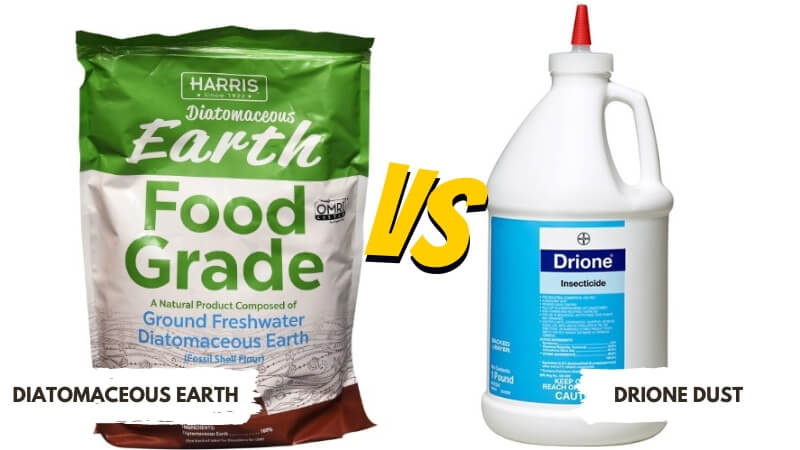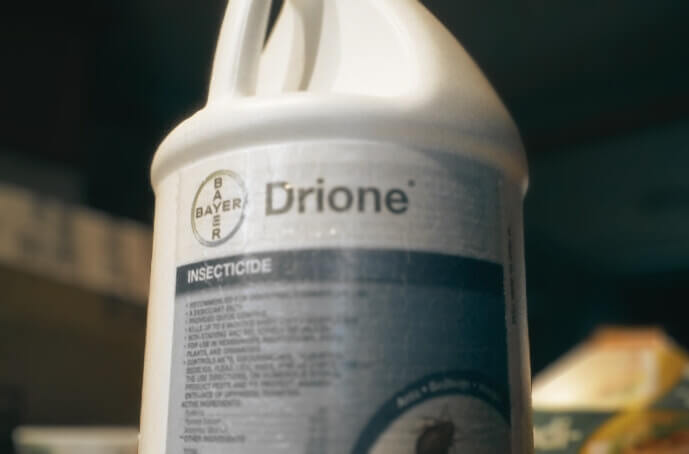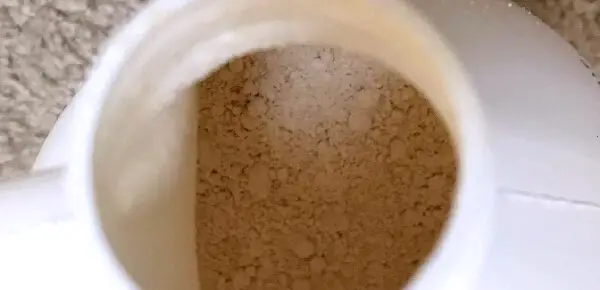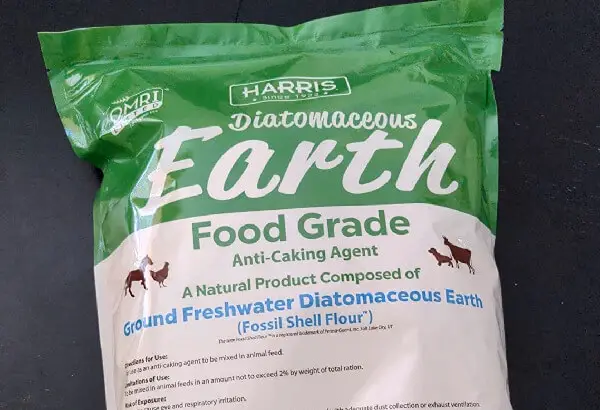Drione Dust vs Diatomaceous Earth

The main difference between Drione Dust and Diatomaceous Earth is that Drione Dust contains synthetic insecticides, while DE is a natural insecticide.
Drione Dust contains pyrethrin and piperonyl butoxide, which are synthetic insecticides, while DE is a natural product made from the fossilized remains of microscopic algae.
Drione Dust vs Diatomaceous Earth
Here is a table chart that will help you understand the differences between various effective insecticides.
Drione Dust | Diatomaceous Earth |
Active Ingredient is Piperonyl butoxide 10% Pyrethrins 1% Silica gel 40% | Active Ingredient Silicon Dioxide 88.25% |
Non-staining and Relatively Odorless | Odorless and Non Staining |
Kills up to 6 Months When Left Undisturbed | Remains Effective as Long as the Product Is Present |
Can Be Used to Control Pests in Commercial and Industrial Areas | Use Indoors or Outdoors to Control Listed Crawling Insects on Contact |
EPA Registered Product | EPA Registered Product |
Safe to Use Around Pets and Children | Safe to Use Around Pets and Children |
Good Flushing Action for Identifying Problem Areas or Infestations | Works by Causing Abrasions on Insects as They Come Into Contact |
It Kills Ants, Bees, Bedbugs, Boxelder Bugs, Cadelles, Centipedes, Cheese Mites, Cigarette Beetles, Cockroaches, Spiders and Others | It kills Cockroaches, Ants, Earwigs, Millipedes, Centipedes, Crickets, Silverfish, Fleas, Bedbugs, and Other Crawling Insects |
Active Ingredient
Drione Dust contains the active ingredients Pyrethrins (1.0%), Piperonyl Butoxide (10.0%), and Silica Gel (40.0%). Pyrethrins target the nervous system of insects, while Piperonyl Butoxide inhibits resistance to the pyrethrins.
The Silica Gel dehydrates insects. Diatomaceous Earth, on the other hand, is made from the fossilized remains of tiny aquatic organisms called diatoms. The sharp edges of the diatom particles are what cause physical damage to insects.

For Use in
Both Drione Dust and Diatomaceous Earth can be used both indoors and outdoors. However, Drione Dust is intended for use in specific settings like residences, institutions, food plants, warehouses, restaurants, hospitals, and more.
Diatomaceous earth is more general purpose and advertised as having hundreds of uses. It is also often marketed as chemical-free and safe for children and pets.
Target Pest
Diatomaceous Earth is effective against Ants, Cockroaches, Earwigs, Fleas, Bed Bugs, and Almost All Other Crawling Insects since it kills physically.
Drione Dust also kills a wide range of pests, including ants, bedbugs, bees, cockroaches, termites, fleas, silverfish, spiders, ticks, and more, through chemical poisoning. A key difference is diatomaceous earth is non-selective, while Drione targets specific pests.
How it Works
Diatomaceous earth kills pests by physically piercing their exoskeletons, causing insects to lose water and dehydrate. The sharp edges slice open exoskeletons and damage soft pest bodies.
Drione Dust works differently by overexciting an insect’s nervous system on contact through pyrethrins, leading to paralysis and death. The added silica gel also causes exoskeleton abrasion and dehydration.

Where to Use
Drione Dust is intended for crack-and-crevice treatment in specific indoor and outdoor locations like homes, hospitals, food plants, and more.
Diatomaceous earth is advertised as being usable in hundreds of applications, both indoors and outdoors. It is often marketed as chemical-free for use around children and pets when following product instructions.
Coverage Area
One pound of Drione Dust covers approximately 1,000 square feet. Diatomaceous earth coverage depends on the product, but typically, 1 lb covers around 800 square feet.
Coverage rates may vary based on the thickness of the application and how deep it penetrates cracks and crevices. Proper distribution is important for both products.
Low Odor
Drione Dust is relatively odorless, making it suitable for indoor use. Diatomaceous earth also does not have a strong odor.
When used correctly, diatomaceous earth can also help absorb and neutralize unpleasant smells. Neither product should leave a significant odor.

Long-Lasting Residual
When left undisturbed, Drione Dust provides residual pest control for up to 6 months indoors. Diatomaceous earth remains effective as long as it is kept dry and undisturbed.
It must be replaced if it gets wet or is disrupted. Both can provide long-term control when applied correctly in inaccessible areas.
Dusting Application
The light and dust-like nature of Drione Dust makes it best applied with a hand duster to target cracks, crevices, and voids effectively.
Diatomaceous earth also comes with or recommends using a powder duster for efficient and easy application into nooks, cracks, and hard to reach areas where insects hide and travel.
Additional Info
Drione Dust can be applied in food areas of food handling establishments in a crack-and-crevice capacity. Food-grade diatomaceous earth is also advertised as safe for mixing into animal feeds as an additive.
It can also help absorb and reduce odors when appropriately used. Both insecticides are useful tools, but they work in different ways.
Our Observation
Based on the data, diatomaceous earth is the better choice for most residential and general pest control needs. Its chemical-free mode of action makes it versatile and safe when used as directed.
Diatomaceous earth can be employed both indoors and outdoors for broad-spectrum control. The fossilized diatom particles provide long-lasting control when kept dry.
For commercial use in food plants, warehouses, and hospitals, Drione Dust may be preferred for its targeted control of key pests like roaches and bed bugs in crack-and-crevice applications. However, for most purposes, we recommend diatomaceous earth as an effective, natural insecticide.

James E. Butkovich, Pest control maven with a knack for eco-friendly & Chemical solutions. Blogger with a mission to make homes pest-free, one post at a time.

